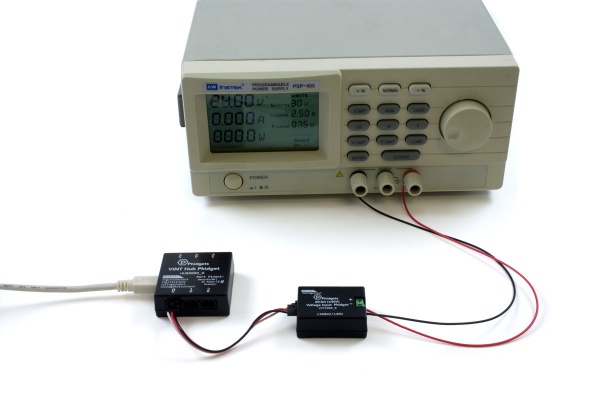VCP1000 User Guide
Part 1: Setup
Welcome to the VCP1000 user guide! In order to get started, make sure you have the following hardware on hand:
- VCP1000 - 20-bit (±40V) Voltage Input Phidget
- VINT Hub
- Phidget cable
- USB cable and computer
- something to use with the VCP1000 (e.g. a voltage source, a voltage output device, etc.)
Next, you will need to connect the pieces:

- Connect the VCP1000 to the VINT Hub using the Phidget cable.
- Connect the voltage source to the terminals of the Voltage Input Phidget (ground to the minus terminal, supply to the plus terminal).
- Connect the VINT Hub to your computer with a USB cable.
Now that you have everything together, let's start using the VCP1000!
Phidget Control Panel
In order to demonstrate the functionality of the VCP1000, the Phidget Control Panel running on a Windows machine will be used.
The Phidget Control Panel is available for use on both macOS and Windows machines.
Windows
To open the Phidget Control Panel on Windows, find the ![]() icon in the taskbar. If it is not there, open up the start menu and search for Phidget Control Panel
icon in the taskbar. If it is not there, open up the start menu and search for Phidget Control Panel
macOS
To open the Phidget Control Panel on macOS, open Finder and navigate to the Phidget Control Panel in the Applications list. Double click on the ![]() icon to bring up the Phidget Control Panel.
icon to bring up the Phidget Control Panel.
For more information, take a look at the getting started guide for your operating system:
Linux users can follow the getting started with Linux guide and continue reading here for more information about the VCP1000.
First Look
After plugging the VCP1000 into your computer and opening the Phidget Control Panel, you will see something like this:

The Phidget Control Panel will list all connected Phidgets and associated objects, as well as the following information:
- Serial number: allows you to differentiate between similar Phidgets.
- Channel: allows you to differentiate between similar objects on a Phidget.
- Version number: corresponds to the firmware version your Phidget is running. If your Phidget is listed in red, your firmware is out of date. Update the firmware by double-clicking the entry.
The Phidget Control Panel can also be used to test your device. Double-clicking on an object will open an example.
Part 2: Using Your Phidget
About
The VCP1000 allows you to measure voltages up to ±40V. This Phidget is ideal for monitoring power supplies, adapting devices to be used with Phidgets, or other voltage monitoring applications. You can manually select the voltage range (±312mV, or ±40V) in your program to maximize the resolution of your measurements.
Explore Your Phidget Channels Using The Control Panel
You can use your Control Panel to explore your Phidget's channels.
1. Open your Control Panel, and you will find the 20-bit (+-40V) Voltage Input Phidget channel:

2. Double click on the channel to open an example program. This channel belongs to the Voltage Input channel class:
In your Control Panel, double click on "20-bit (+-40V) Voltage Input Phidget":
Part 3: Create your Program
1. Setting up your Programming Environment
Part 4: Advanced Topics and Troubleshooting
Before you open a Phidget channel in your program, you can set these properties to specify which channel to open. You can find this information through the Control Panel.
1. Open the Control Panel and double-click on the red map pin icon:

2. The Addressing Information window will open. Here you will find all the information you need to address your Phidget in your program.

See the Phidget22 API for your language to determine exact syntax for each property.
The Change Trigger is the minimum change in the sensor data needed to trigger a new data event.
The Data Interval is the time (in ms) between data events sent out from your Phidget.
The Data Rate is the reciprocal of Data Interval (measured in Hz), and setting it will set the reciprocal value for Data Interval and vice-versa.
You can modify one or both of these values to achieve different data outputs. You can learn more about these properties here.
The VCP1000 is electrically isolated. A power surge in the circuit being measured would only affect the VCP1000, so your VINT Hub or computer will remain unharmed. Having isolation also helps prevent the formation of ground loops in your system.
With isolation on the VCP1000, you can measure the voltage differential between two points of a circuit regardless of their relation to ground. The voltage differential between those points must be within the specification of the sensor.
For example, in the pictured battery charging circuit, there is sufficient complexity between the battery and VINT Hub that directly measuring the voltage with a non-isolated sensor could be a risky proposition. However, with VCP1000, the battery voltage may be measured directly, ignoring the circuits in between.

